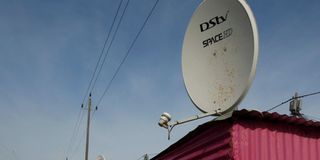Covid-19 costs pay TVs 110,000 customers - UCC

The suspension of major sports leagues such as the English Premier League and UEFA Champions League affected subscriber numbers for Pay Tv service providers such as DStv in the first quarter of 2020. PHOTO | FILE
What you need to know:
According to the Uganda Communications Commission report, which covers the first quarter of 2020, there was a contraction of 6 per cent in comparison to active Pay TV subscriptions at the end of the fourth quarter of 2019.
Pay television service providers saw a reduction in the number of active subscribers from 1.69 million in December 2019 to 1.58 million in the first quarter of 2020.
A Uganda Communications Commission (UCC) report for the period reveals that there was a contraction of 6 per cent in comparison to active Pay TV subscriptions at the end of the fourth quarter of 2019.
“This may in part be attributed to the suspension of major sports leagues such as the English Premier League and UEFA Champions League due to the novel Coronavirus,” the report, which reviews the performance of the Pay TV segment, reads in part.
Pay TV subscriptions have been growing since the beginning of 2019 but was affected in the first quarter of 2020.
For instance, subscribers grew from 1.1 million in January 2019 to 1.69 million in December 2019.
However, the drop witnessed in March is partly attributed to Covid-19, which caused a halt to many activities, especially in the world of sports.
Return of sports broadcast Sports such as football have only recently resumed with leagues and players following strict standards of operations.
“The most immediate impact to our offering was the postponement of all live sport,” Multichoice’s DStv, said in its 2020 annual results for the year ended 2020.
In addition, a reduction in disposable income as people were saving for the murky future, while others lost their jobs or endured salary cuts, could explain the dip in active subscription.
Price, according to UCC, is a critical determinant for subscribers and subscriber numbers, by and large, vary heavily with price.
“The cheapest bouquet offerings on average represent 40 per cent of a given service provider’s subscriber base, while the most expensive account for 13 per cent,” the report reads.
Industry information indicates that Azam, Startimes and GOtv offer the cheapest basic bouquets while Startimes terrestrial offers the cheapest premium brand.
Uganda has seven Pay TV service providers including DStv, Zuku, Azam, Startimes and Kampala Siti cable, which took over Kwese TV.
Free to air channels on the other hand, which are delivered and carried on the Signet platform via the government-owned company, Signet Uganda were 39 by the end of March 2020.
Local content
Finance In 2013, UCC issued a directive to both Pay TV and free to air services providers requiring them to air 20 per cent and 70 per cent of local content, respectively.
The report indicates that Pay TV service providers have now increased promotion of local content by acquiring local films and setting up channels to show local content.
At the moment, DStv, GOTv and Startimes are the leading Pay Tv broadcasters of local content.
However, local channels are still less than international channels with average local content ranking at 22 per cent.
DStv on the other hand revealed in its 2020 results that it would focus more on local content as a means of cutting costs.
“... as a result, we are stepping up our investment in local content and high-quality local productions. Shifting more of our spend locally, thereby reducing our exposure to international dollar-based costs, is also an integral part of our overall strategy, which positively impacts our cost containment initiatives,” the Pay TV said in its results and noted that owing to the ongoing optimisation of its content strategy, it eliminated R0.4bn of content costs from its cost base during the year.



